During its recent restoration, Boston College' original eagle sculpture was revealed to be a Japanese masterpiece from the Meiji period.
Eaglemania: Collecting Japanese Art in Gilded Age America at the McMullen Museum of Art is an exhibition that celebrates and contextualizes Boston College’s monumental bronze eagle, a sculptural representation of the University's mascot which, during its recent restoration, was revealed to be a Japanese masterpiece from the Meiji period (1868–1912). Conservation has drawn attention to the eagle’s significant fine detail, careful modeling of form, and excellence of material construction, inspiring scholars’ desire to understand its origins.
The restored piece will be unveiled as the centerpiece of the exhibition, which will explore Meiji bronze production, the depiction of birds of prey in Japanese art, and the fascination of late 19th-century Americans—and Boston Brahmins in particular—with Japanese art and culture. The exclusive exhibition will be on display in the McMullen Museum’s Daley Family Gallery from February 11 through June 2.
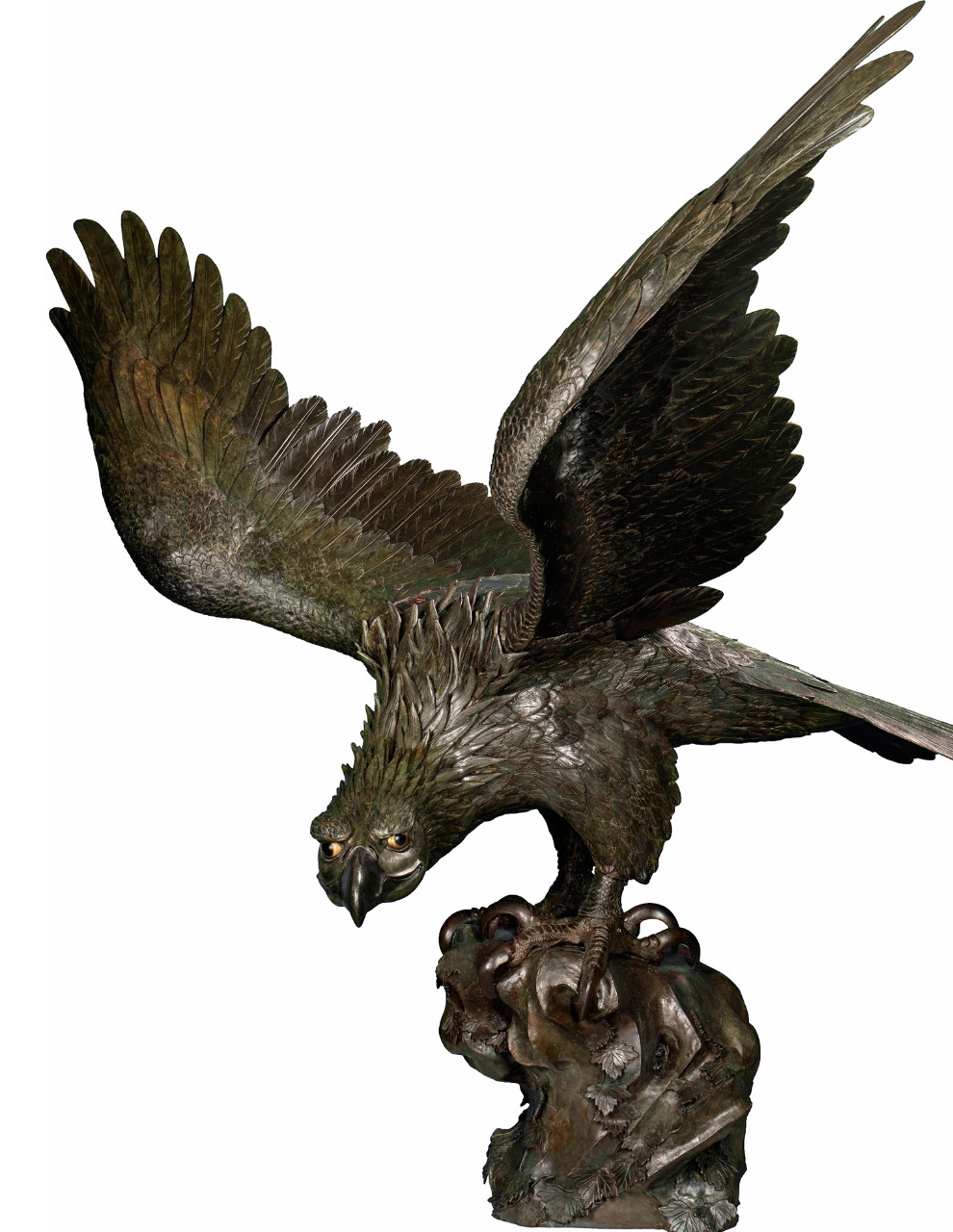
Eagle, c. 1890s; attributed to Suzuki Chōkichi (1848–1919). Bronze, gold, shakudō, c. 75 x 67 x 49 in., McMullen Museum of Art
“The McMullen Museum is pleased to celebrate the painstaking restoration and research that recently revealed the artistic significance of a virtually lost monumental bronze masterpiece from Japan’s Meiji period,” said McMullen Museum Director and Professor of Art History Nancy Netzer. “The exhibition and accompanying scholarly volume contextualize the history of Boston College’s eagle sculpture and the argument for its probable attribution to the circle of master artist Suzuki Chkichi [1848–1919] with an array of magnificent loans, many of which have never been displayed publicly in New England.”
Also on view during this period will be an exhibition in the museum’s Monan Gallery, Cuenca: City of Spanish Abstraction. The McMullen is the first American museum to offer a retrospective of the founding of the renowned Museo de Arte Abstracto Español in Cuenca, Spain. The exhibition comprises rarely shown works on paper by 14 leading Spanish abstract artists.
Boston College faculty, staff, and students are invited to preview the exhibitions on February 10 from noon to 5 p.m. The event will include a 2 p.m. presentation, “Cuenca: City of Spanish Abstraction” by Manuel Fontán del Junco and María Toledo of the Fundación Juan March; and a 2:45 p.m. presentation, “Eaglemania: Collecting Japanese Art in Gilded Age America,” by curators McMullen Museum Assistant Director Diana Larsen and Victoria Weston, an associate professor of art at the University of Massachusetts-Boston, who edited the exhibition catalogue. RSVP for the preview here.
“Eaglemania: Collecting Japanese Art in Gilded Age America”
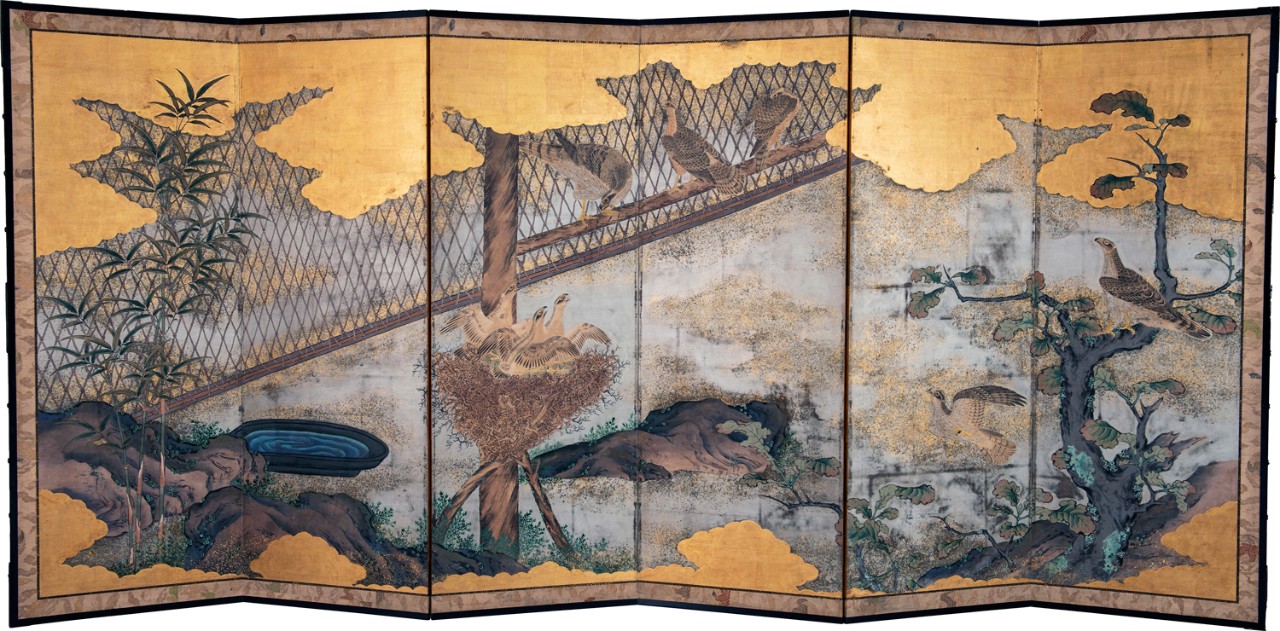
Estate Birds, c. 1780. Paper, wood, paint, ink, gold leaf, 68 x 153 x 0.8 in., private collection.
The original eagle was fully gilded after its donation to Boston College in the 1950s by the estate of diplomat and collector Larz Anderson (1866–1937) and his wife, Isabel (1876–1948). Weathered over nearly four decades, a replica was recast to take its place outdoors and the original went into storage in the 1990s. That replica presides over campus atop a 34-four-foot granite column in front of Gasson Hall.
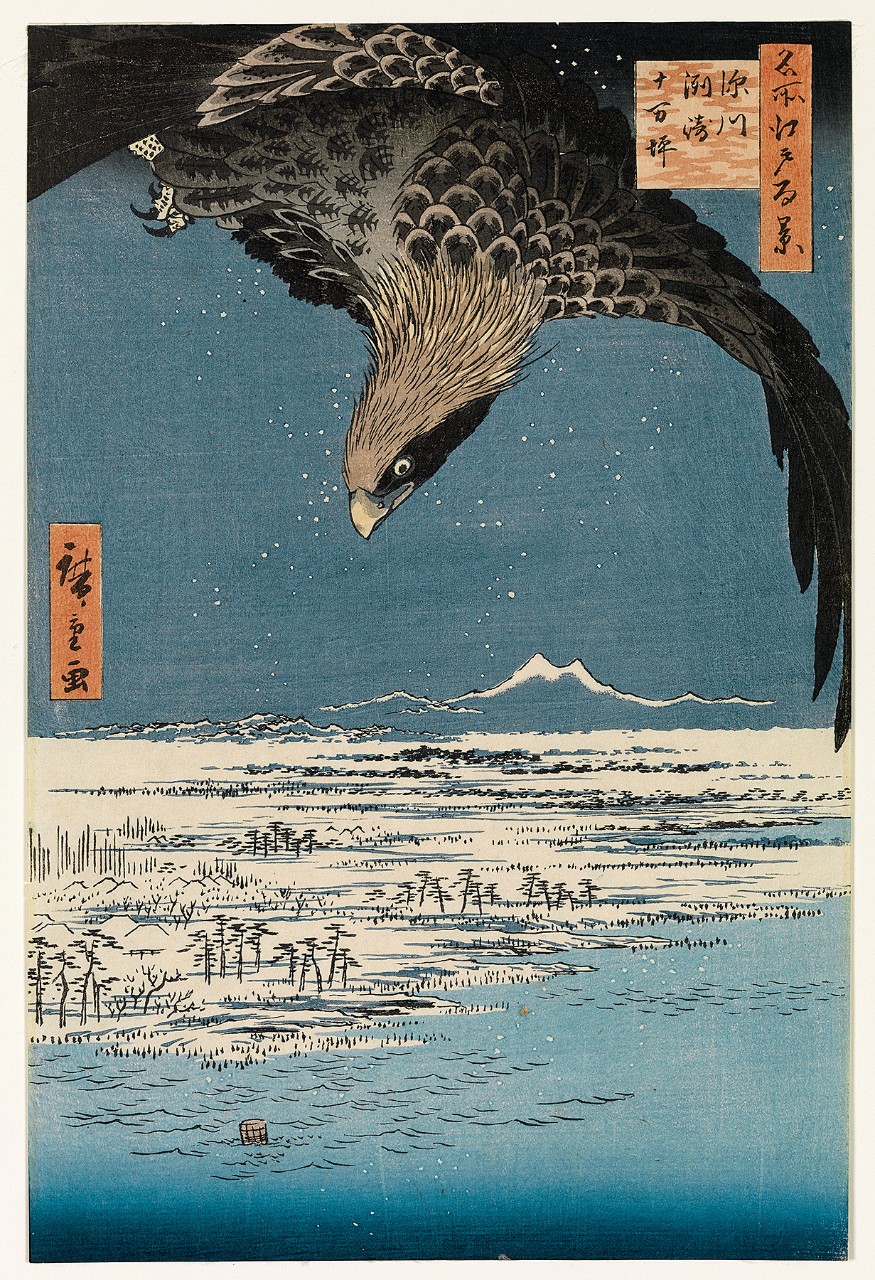
Ando Hiroshige (1797–1858), The 10,000 Acres Plain at Suzaki, Fukagawa, no. 107 from One Hundred Famous Views of Edo, late 1850s. Woodblock print, ink and colors on paper, 13 x 8.8 in. (sheet), Smith College Museum of Art
A new assessment of the original work deemed it worthy of restoration, a process that began in 2017, and involved careful study, reconstruction, and repatination to return the sculpture to its 19th-century appearance. As a work of art and social history, the eagle sparked a host of questions that resulted in this project. In its restored glory, it presides over the exhibition, the galleries inspired by the many themes that emerged in the course of research.
Though its authorship is unknown, “one name looms large,” according to the introduction in the accompanying catalogue: imperial court artist Suzuki Chkichi, “perhaps Japan’s best known metals artist, who famously exhibited hawks and eagles in international arts competitions.”
The exhibition comprises bronze, silver, and ivory sculptures of birds of prey, folding screens, scroll paintings, netsuke, lacquerware, ceramics, and textiles, which join to bring the history of the stunning Boston College eagle to life.
Organized by the McMullen Museum of Art, “Eaglemania” has been underwritten by Boston College with major support from the Patrons of the McMullen Museum and Peter and Leslie Ciampi.
“Cuenca: City of Spanish Abstraction”
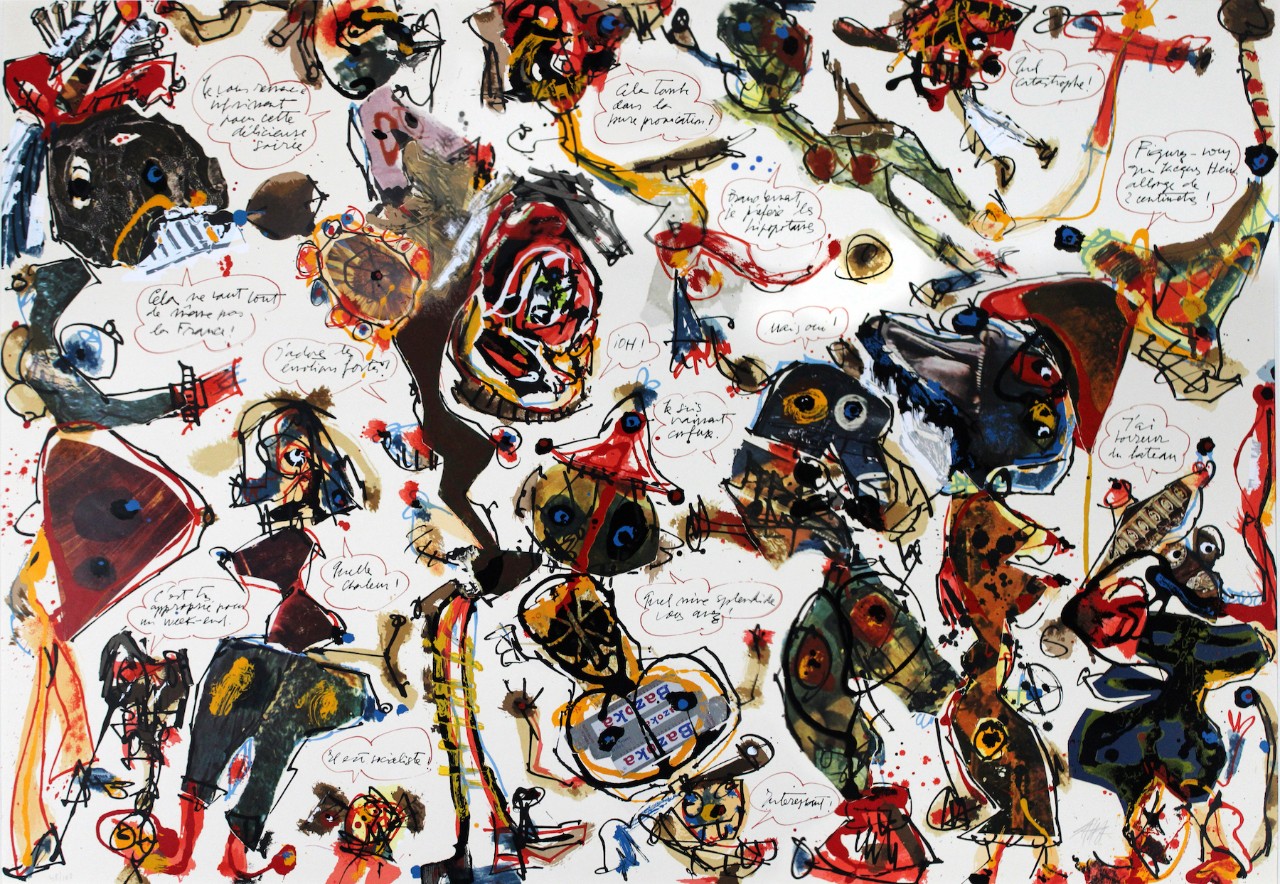
Antonio Saura (1930–89), Cocktail Party, 1960 (48/100). Serigraph with collage on paper, 69 x 98 cm, Colección Fundación Juan March, Museo de Arte Abstracto Español, Cuenca, 1227G.
The concurrent exhibition at the McMullen, “Cuenca: City of Spanish Abstraction,” examines many of the first artists associated with the now-renowned Museo de Arte Abstracto Español, including Fernando Zóbel, Gustavo Torner, Gerardo Rueda, Eusebio Sempere, Eduardo Chillida, and Manuel Millares.
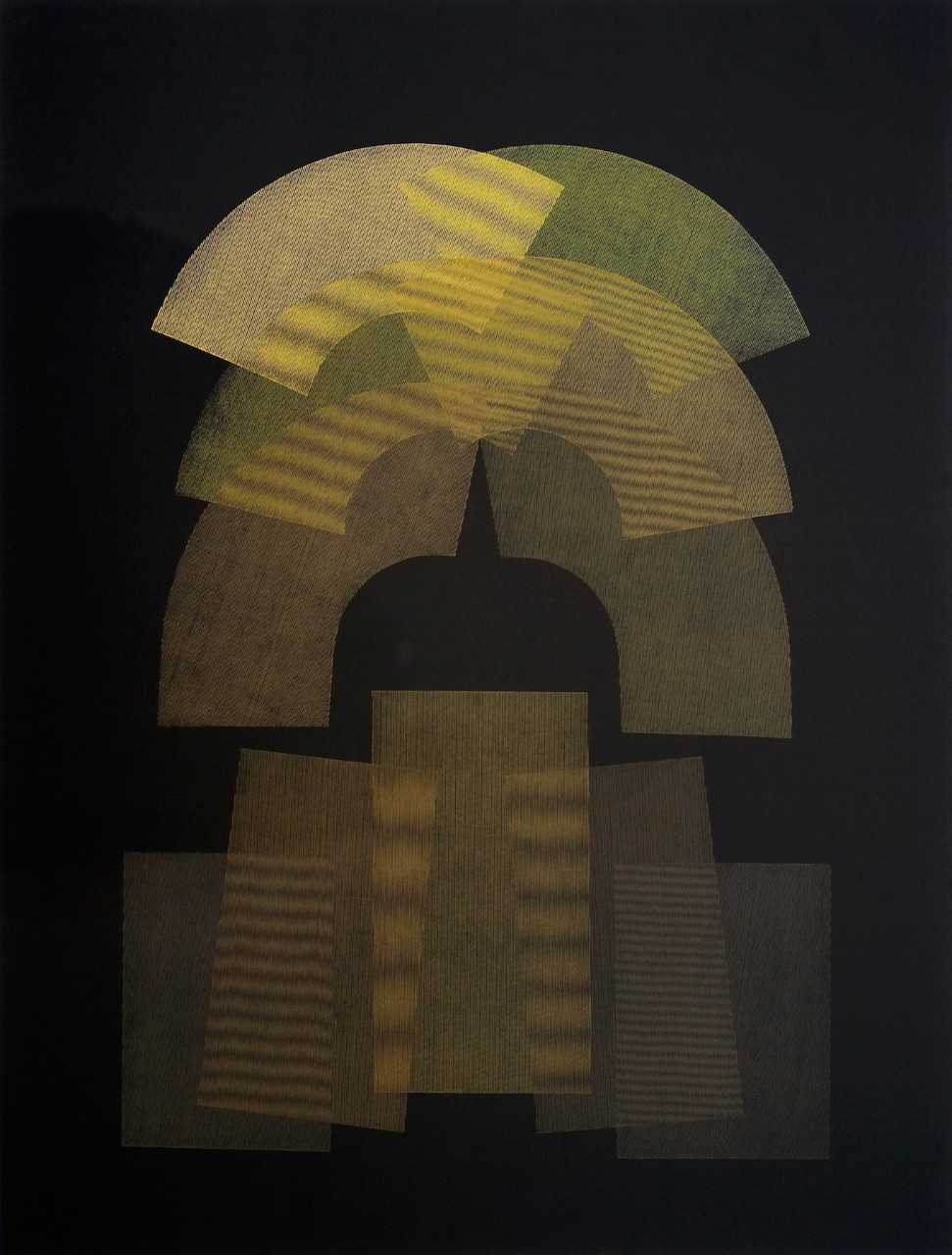
Eusebio Sempere (1923–85), Sin título, n.d. (158/200). Serigraph on black Canson paper, 64.5 x 49.5 cm, Colección Fundación Juan March, Museo de Arte Abstracto Español, Cuenca, 0811G.
Founded by Fernando Zóbel in the 1960s during the repressive regime of General Francisco Franco, the Museo became a literal refuge for artists seeking an environment of collaboration and innovation. Perched in the “hanging houses” of the medieval city, the Museo supported resistance against the current cultural and political climate, providing artists practicing abstraction with workshops to create prints and galleries in which to display them.
“It is an honor to work with the Fundación Juan March to be the first museum in America to offer a retrospective look at the genius behind the founding of the Museo de Arte Abstracto Español in Cuenca and to pay tribute to the outstanding work born of collaboration among the earliest abstract artists associated with the city,” Netzer said.
Organized by the McMullen Museum in conjunction with the Fundación Juan March, the exhibition—curated by Elizabeth Thompson Goizueta, part-time faculty member in Romance Languages and Literatures Department—has received major support from the Patrons of the McMullen Museum.
For more information on these exhibitions, and accompanying events at the McMullen Museum, see www.bc.edu/artmuseum.
Rosanne Pellegrini | University Communications




